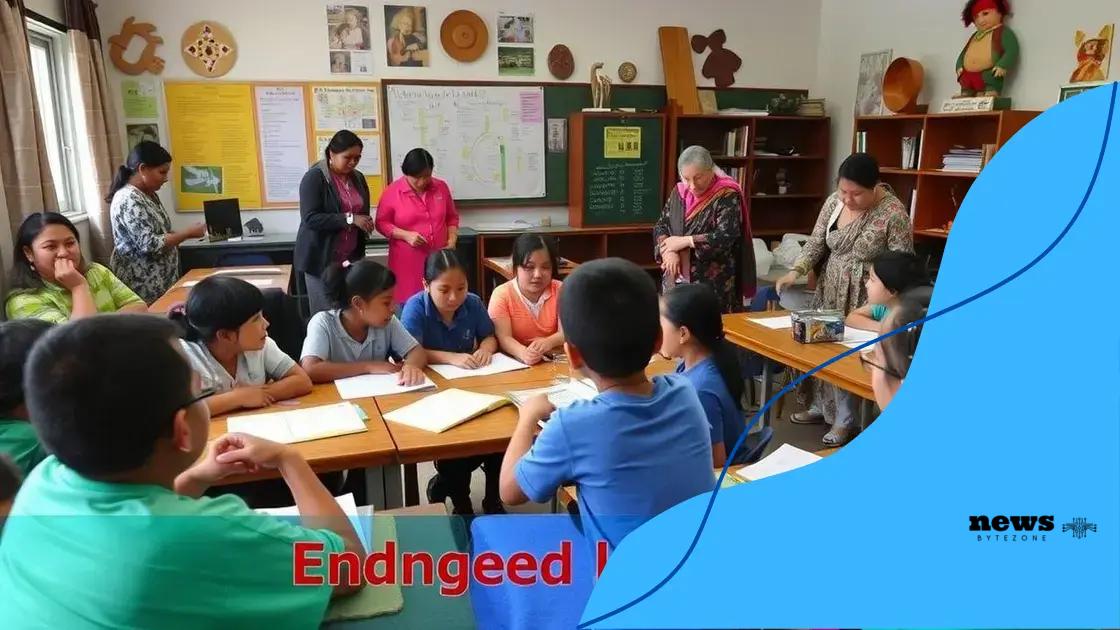Language preservation in schools is crucial for maintaining cultural identity, requiring community involvement, effective teaching methods, and resources to ensure endangered languages thrive for future generations.
Language preservation: teaching endangered languages in schools is essential for maintaining cultural diversity. Ever thought about how these languages shape our identities? Let’s dive into this important issue.
The importance of preserving endangered languages
Understanding the importance of preserving endangered languages is vital for cultural heritage. These languages connect us to our history and identity. When a language fades away, it takes with it unique perspectives and traditional knowledge.
Cultural Significance
Every language reflects the culture of its speakers. It embodies their stories, beliefs, and customs. By preserving endangered languages, we not only retain cultural diversity but also promote mutual respect and understanding among different communities.
Threats to Endangered Languages
Various factors contribute to the decline of these languages. Here are some of the major threats:
- Globalization and urbanization
- Migration and cultural assimilation
- Lack of educational resources in native languages
- Negative attitudes towards minority languages
Each of these threats weakens the presence of a language in daily life, making it less likely for future generations to learn it.
Benefits of Preservation
Preserving endangered languages offers numerous benefits:
- Enhances our understanding of human cognition
- Strengthens cultural identity and pride
- Encourages community cohesion and solidarity
- Provides valuable insights into biodiversity and environmental knowledge.
Incorporating these languages in education helps students appreciate their cultural heritage.
By recognizing the importance of preserving endangered languages, we can motivate actions that support their survival. Each language holds the key to understanding diverse worldviews and traditions. Therefore, taking steps to revitalize these languages is essential, not just for the speakers, but for humanity as a whole.
Effective teaching methods for endangered languages
Effective teaching methods for endangered languages are essential to keep these cultural treasures alive. Educators need to engage students with practical approaches that enhance learning and foster appreciation for the language.
Immersion Programs
One of the best ways to teach endangered languages is through immersion programs. In these programs, students are surrounded by the language and culture all day long. This exposure helps beginners start thinking and communicating in that language quickly.
Interactive Learning
Another great method is using interactive learning techniques. Activities like role-playing and group discussions make learning fun. They encourage students to use the language in real situations, enhancing their speaking and listening skills.
Games can also be an effective way to engage students. For example, vocabulary-building games create a lively learning environment and make practicing the language appealing.
Cultural Integration
Integrating cultural elements into lessons is crucial for effective teaching. This includes traditional songs, stories, and customs that enrich the learning experience. When students connect the language with its culture, they see the importance of preserving endangered languages more clearly.
Besides cultural activities, incorporating technology can provide exciting learning opportunities. Online resources, mobile apps, or even social media groups can be powerful tools for students to practice the language outside of the classroom.
By combining these methods, educators can create an engaging and supportive atmosphere for students to learn endangered languages. Effective teaching goes beyond grammar and vocabulary; it nurtures a sense of identity and belonging.
Integrating endangered languages into the curriculum

Integrating endangered languages into the curriculum is an essential step in promoting language preservation. This integration enriches the educational experience and cultivates respect for diverse cultures.
Curriculum Design
Creating a curriculum that includes endangered languages involves careful planning. Educators should consider the local community and the languages spoken by students. This connection promotes a sense of belonging and prioritizes cultural relevance.
Cross-Disciplinary Approach
Using a cross-disciplinary approach enhances learning. For example, language lessons can incorporate history, art, and music. This way, students learn about their heritage through various subjects, making lessons more engaging.
Activities such as storytelling and music appreciation can be wonderful tools. These techniques draw on students’ interests and make learning more enjoyable.
Community Involvement
Involving the community is key to successful integration. Schools can collaborate with local speakers to conduct guest lectures or workshops. These interactions help highlight the importance of the language and its cultural significance.
- Organize cultural events featuring local languages.
- Create partnerships with community organizations focused on language preservation.
- Encourage students to conduct interviews with native speakers.
Such initiatives foster strong community ties and encourage family participation in education. When families see their language valued in the classroom, it can strengthen their connections to both the language and the school.
To maximize the impact of integrating endangered languages, schools can also use technology. Online courses and resources make it easier for students to access materials related to their heritage. This flexibility encourages continuous learning beyond the classroom.
Challenges schools face in language preservation
Schools face numerous challenges in the effort of language preservation. These obstacles can hinder the teaching and learning of endangered languages, impacting the overall goal of keeping these languages alive.
Lack of Resources
One major challenge is the lack of resources. Many schools struggle to find appropriate teaching materials for endangered languages. This includes textbooks, teaching aids, and trained teachers. Without these resources, effective language education becomes difficult.
Insufficient Training for Educators
Another challenge is the insufficient training for educators. Teachers often lack the skills necessary to teach an endangered language. Many educators are more familiar with dominant languages and may not know how to engage students in a less commonly taught language.
Professional development opportunities are essential to help teachers gain confidence and skills to teach these languages. Without proper training, teachers may feel unprepared to address the unique needs of their students.
Community Support
Community support is critical for language preservation, yet it can be inconsistent. In some cases, family members may prioritize dominant languages over their native languages. This can create a disconnect between school education and family language practices.
- Lack of interest among students can also pose a problem. When students do not perceive the value of learning an endangered language, they may not engage in lessons.
- Resistance from the community regarding curriculum changes can make it difficult to implement new language programs.
- Local governments may not provide the necessary funding for language programs, limiting schools’ ability to offer comprehensive courses.
Addressing these challenges requires collaboration between schools, families, and the community. Engaging parents and community leaders in the discussion can raise awareness of the importance of preserving endangered languages.
Community involvement in language education
Community involvement in language education plays a crucial role in the preservation and revival of endangered languages. When communities actively participate, they create a supportive network that enhances learning and ensures that the languages are passed down through generations.
Building Partnerships
Creating strong partnerships between schools and community organizations can greatly enrich language education. Local cultural groups can provide resources, such as native speakers who volunteer as guest teachers. These partnerships help students connect with the language in real-life contexts.
Workshops and Cultural Events
Hosting workshops and cultural events is an effective way to boost community involvement. These activities allow community members to showcase their heritage. When students participate in cultural events, they gain a deeper appreciation for the language and its significance.
- Invite community members to share stories and traditions related to the language.
- Organize language fairs where students can practice speaking with native speakers.
- Encourage participation in traditional dances, songs, and crafts that use the language.
Such experiences help students see language as a living part of their culture.
Encouraging Parental Engagement
Parental engagement is crucial for reinforcing language education at home. Schools should encourage parents to be involved in their children’s language learning. This can include activities like reading together or practicing vocabulary at home.
When parents show interest in learning the language alongside their children, it strengthens family bonds. It makes language learning a shared experience, enhancing motivation for both students and parents.
To support this, schools can provide resources and workshops tailored to families. These resources can help parents gain the confidence they need to assist their children in their language education.
FAQ – Frequently Asked Questions about Language Preservation in Schools
Why is community involvement important in language education?
Community involvement enriches language education by providing authentic resources and support, helping students connect culturally.
What challenges do schools face in preserving endangered languages?
Schools often struggle with a lack of resources, insufficient teacher training, and inconsistent community support.
How can parents support their children’s language learning?
Parents can support language learning by engaging in activities at home, such as reading together and practicing vocabulary.
What teaching methods are effective for endangered languages?
Effective methods include immersion programs, interactive learning techniques, and integrating cultural elements into the curriculum.

 Environmental education: integrating sustainability into curricula
Environmental education: integrating sustainability into curricula  The impact of sleep on student performance and well-being
The impact of sleep on student performance and well-being  Coding bootcamps vs. traditional degrees: what’s right for you?
Coding bootcamps vs. traditional degrees: what’s right for you?